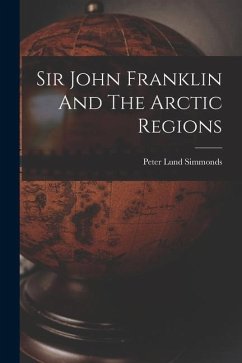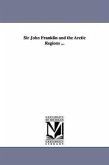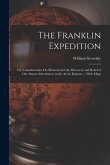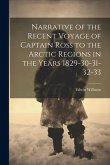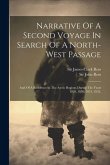Peter Lund Simmonds
Sir John Franklin And The Arctic Regions
Peter Lund Simmonds
Sir John Franklin And The Arctic Regions
- Broschiertes Buch
- Merkliste
- Auf die Merkliste
- Bewerten Bewerten
- Teilen
- Produkt teilen
- Produkterinnerung
- Produkterinnerung
This work has been selected by scholars as being culturally important, and is part of the knowledge base of civilization as we know it. This work is in the "public domain in the United States of America, and possibly other nations. Within the United States, you may freely copy and distribute this work, as no entity (individual or corporate) has a copyright on the body of the work. Scholars believe, and we concur, that this work is important enough to be preserved, reproduced, and made generally available to the public. We appreciate your support of the preservation process, and thank you for…mehr
Andere Kunden interessierten sich auch für
![Sir John Franklin and the Arctic Regions Sir John Franklin and the Arctic Regions]() Peter Lund SimmondsSir John Franklin and the Arctic Regions38,99 €
Peter Lund SimmondsSir John Franklin and the Arctic Regions38,99 €![Voyage of the Prince Albert in Search of Sir John Franklin Voyage of the Prince Albert in Search of Sir John Franklin]() William Parker SnowVoyage of the Prince Albert in Search of Sir John Franklin28,99 €
William Parker SnowVoyage of the Prince Albert in Search of Sir John Franklin28,99 €![The Eventful Voyage Of H. M. Discovery Ship "e;resolute"e; To The Arctic Regions In Search Of Sir John Franklin And The Missing Crews Of H. M. Discovery S The Eventful Voyage Of H. M. Discovery Ship "e;resolute"e; To The Arctic Regions In Search Of Sir John Franklin And The Missing Crews Of H. M. Discovery S]() George F. McDougallThe Eventful Voyage Of H. M. Discovery Ship "e;resolute"e; To The Arctic Regions In Search Of Sir John Franklin And The Missing Crews Of H. M. Discovery S33,99 €
George F. McDougallThe Eventful Voyage Of H. M. Discovery Ship "e;resolute"e; To The Arctic Regions In Search Of Sir John Franklin And The Missing Crews Of H. M. Discovery S33,99 €![Sir John Franklin and the Arctic Regions ... Sir John Franklin and the Arctic Regions ...]() Peter Lund SimmondsSir John Franklin and the Arctic Regions ...34,99 €
Peter Lund SimmondsSir John Franklin and the Arctic Regions ...34,99 €![The Franklin Expedition: Or, Considerations On Measures for the Discovery and Relief of Our Absent Adventurers in the Arctic Regions ... With M The Franklin Expedition: Or, Considerations On Measures for the Discovery and Relief of Our Absent Adventurers in the Arctic Regions ... With M]() William ScoresbyThe Franklin Expedition: Or, Considerations On Measures for the Discovery and Relief of Our Absent Adventurers in the Arctic Regions ... With M19,99 €
William ScoresbyThe Franklin Expedition: Or, Considerations On Measures for the Discovery and Relief of Our Absent Adventurers in the Arctic Regions ... With M19,99 €![Narrative of the Recent Voyage of Captain Ross to the Arctic Regions in the Years 1829-30-31-32-33 Narrative of the Recent Voyage of Captain Ross to the Arctic Regions in the Years 1829-30-31-32-33]() Edwin WilliamsNarrative of the Recent Voyage of Captain Ross to the Arctic Regions in the Years 1829-30-31-32-3320,99 €
Edwin WilliamsNarrative of the Recent Voyage of Captain Ross to the Arctic Regions in the Years 1829-30-31-32-3320,99 €![Narrative Of A Second Voyage In Search Of A North-west Passage: And Of A Residence In The Arctic Regions During The Years 1829, 1830, 1831, 1832, Narrative Of A Second Voyage In Search Of A North-west Passage: And Of A Residence In The Arctic Regions During The Years 1829, 1830, 1831, 1832,]() John RossNarrative Of A Second Voyage In Search Of A North-west Passage: And Of A Residence In The Arctic Regions During The Years 1829, 1830, 1831, 1832,41,99 €
John RossNarrative Of A Second Voyage In Search Of A North-west Passage: And Of A Residence In The Arctic Regions During The Years 1829, 1830, 1831, 1832,41,99 €-
-
-
This work has been selected by scholars as being culturally important, and is part of the knowledge base of civilization as we know it. This work is in the "public domain in the United States of America, and possibly other nations. Within the United States, you may freely copy and distribute this work, as no entity (individual or corporate) has a copyright on the body of the work. Scholars believe, and we concur, that this work is important enough to be preserved, reproduced, and made generally available to the public. We appreciate your support of the preservation process, and thank you for being an important part of keeping this knowledge alive and relevant.
Produktdetails
- Produktdetails
- Verlag: LEGARE STREET PR
- Seitenzahl: 422
- Erscheinungstermin: 27. Oktober 2022
- Englisch
- Abmessung: 234mm x 156mm x 22mm
- Gewicht: 590g
- ISBN-13: 9781018691503
- ISBN-10: 1018691502
- Artikelnr.: 66705961
- Verlag: LEGARE STREET PR
- Seitenzahl: 422
- Erscheinungstermin: 27. Oktober 2022
- Englisch
- Abmessung: 234mm x 156mm x 22mm
- Gewicht: 590g
- ISBN-13: 9781018691503
- ISBN-10: 1018691502
- Artikelnr.: 66705961
Peter Lund Simmonds, a prolific 19th-century writer and editor, authored the noteworthy work "The Curiosities of Food: Or, The Dainties and Delicacies of Different Nations Obtained from the Animal Kingdom." Simmonds became an English author, agriculturalist, and advocate for technological advancements in agriculture in the course of the Victorian era. In his masterful book, "The Curiosities of Food," Simmonds explores the fascinating and diverse global of culinary delights from diverse cultures. The subtitle, "Or The Dainties And Delicacies Of Different Nations Obtained From The Animal Kingdom," guidelines at the focal point at the animal nation as a source of diverse and uncommon ingredients. Simmonds in all likelihood takes readers on a gastronomic journey, detailing specific and curious culinary practices, elements, and dishes from around the globe. The book may delve into the ancient, cultural, and medical factors of meals, offering insights into the ways specific societies have harnessed the bounty of the animal country for sustenance and satisfaction. Simmonds, recognized for his know-how in agricultural and culinary topics, may additionally have infused the book with a blend of clinical inquiry and an appreciation for the wealthy tapestry of world food traditions.
Preface; Introductory remarks; Captain John Ross's voyage in the Isabella and Alexander to Hudson's Bay in 1818; Voyage of Buchan and Franklin in the Dorothea and Trent to Spitzbergen
etc.
1818; Franklin's first land expedition
1819-21; Parry's first voyage in the Hecla and Griper
1819-20; Parry's second voyage in the Fury and Hecla
1821-3; Clavering's voyage to Spitzbergen and Greenland in the Griper
1823; Lyon's voyage in the Griper
1824; Parry's third voyage in the Hecla and Fury
1824-5; Franklin's second land expedition
1825-6; Captain Beechey's voyage to Behring Strait in the Blossom
1826-8; Parry's fourth or Polar voyage in the Hecla
1827; Captain John Ross's second voyage in the Victory
1829-33; Captain Back's land journey in search of Ross
1833-5; Back's voyage in the Terror up Hudson's Strait
1836; Messrs. Dease and Simpson's discoveries on the coast of Arctic America
1836-9; Dr. John Rae's land expedition
1846-7; Captain Sir John Franklin's last expedition in the Erebus and Terror
1845-51; The government and private searching expeditions; Voyage of the Enterprise and Investigator under Captains Sir J. C. Ross and E. J. Bird
1848-9; Voyage of the transport
North Star
1849; Second voyage of the Enterprise and Investigator under Captain Collinson and Commander McClure
1850; Voyage of the Plover
and boat expeditions under Commander Pullen
1848-51; Voyage of the Lady Franklin and Sophia
purchased government ships
under the command of Mr. Penny; Voyage of the Resolute and Assistance
under command of Captain Austin
with their steam tenders
Pioneer and Intrepid
1850-1; Voyage of Captain Sir John Ross in the Felix private schooner
1850-1; American government searching expedition in the US ships Advance and Rescue
under the command of Lieutenant de Haven
1850-1; Remarkable voyage of the private ship
Prince Albert
under the command of Captain Forsyth
R.N.
to Regent Inlet and back
1850; Appendix.
etc.
1818; Franklin's first land expedition
1819-21; Parry's first voyage in the Hecla and Griper
1819-20; Parry's second voyage in the Fury and Hecla
1821-3; Clavering's voyage to Spitzbergen and Greenland in the Griper
1823; Lyon's voyage in the Griper
1824; Parry's third voyage in the Hecla and Fury
1824-5; Franklin's second land expedition
1825-6; Captain Beechey's voyage to Behring Strait in the Blossom
1826-8; Parry's fourth or Polar voyage in the Hecla
1827; Captain John Ross's second voyage in the Victory
1829-33; Captain Back's land journey in search of Ross
1833-5; Back's voyage in the Terror up Hudson's Strait
1836; Messrs. Dease and Simpson's discoveries on the coast of Arctic America
1836-9; Dr. John Rae's land expedition
1846-7; Captain Sir John Franklin's last expedition in the Erebus and Terror
1845-51; The government and private searching expeditions; Voyage of the Enterprise and Investigator under Captains Sir J. C. Ross and E. J. Bird
1848-9; Voyage of the transport
North Star
1849; Second voyage of the Enterprise and Investigator under Captain Collinson and Commander McClure
1850; Voyage of the Plover
and boat expeditions under Commander Pullen
1848-51; Voyage of the Lady Franklin and Sophia
purchased government ships
under the command of Mr. Penny; Voyage of the Resolute and Assistance
under command of Captain Austin
with their steam tenders
Pioneer and Intrepid
1850-1; Voyage of Captain Sir John Ross in the Felix private schooner
1850-1; American government searching expedition in the US ships Advance and Rescue
under the command of Lieutenant de Haven
1850-1; Remarkable voyage of the private ship
Prince Albert
under the command of Captain Forsyth
R.N.
to Regent Inlet and back
1850; Appendix.
Preface; Introductory remarks; Captain John Ross's voyage in the Isabella and Alexander to Hudson's Bay in 1818; Voyage of Buchan and Franklin in the Dorothea and Trent to Spitzbergen
etc.
1818; Franklin's first land expedition
1819-21; Parry's first voyage in the Hecla and Griper
1819-20; Parry's second voyage in the Fury and Hecla
1821-3; Clavering's voyage to Spitzbergen and Greenland in the Griper
1823; Lyon's voyage in the Griper
1824; Parry's third voyage in the Hecla and Fury
1824-5; Franklin's second land expedition
1825-6; Captain Beechey's voyage to Behring Strait in the Blossom
1826-8; Parry's fourth or Polar voyage in the Hecla
1827; Captain John Ross's second voyage in the Victory
1829-33; Captain Back's land journey in search of Ross
1833-5; Back's voyage in the Terror up Hudson's Strait
1836; Messrs. Dease and Simpson's discoveries on the coast of Arctic America
1836-9; Dr. John Rae's land expedition
1846-7; Captain Sir John Franklin's last expedition in the Erebus and Terror
1845-51; The government and private searching expeditions; Voyage of the Enterprise and Investigator under Captains Sir J. C. Ross and E. J. Bird
1848-9; Voyage of the transport
North Star
1849; Second voyage of the Enterprise and Investigator under Captain Collinson and Commander McClure
1850; Voyage of the Plover
and boat expeditions under Commander Pullen
1848-51; Voyage of the Lady Franklin and Sophia
purchased government ships
under the command of Mr. Penny; Voyage of the Resolute and Assistance
under command of Captain Austin
with their steam tenders
Pioneer and Intrepid
1850-1; Voyage of Captain Sir John Ross in the Felix private schooner
1850-1; American government searching expedition in the US ships Advance and Rescue
under the command of Lieutenant de Haven
1850-1; Remarkable voyage of the private ship
Prince Albert
under the command of Captain Forsyth
R.N.
to Regent Inlet and back
1850; Appendix.
etc.
1818; Franklin's first land expedition
1819-21; Parry's first voyage in the Hecla and Griper
1819-20; Parry's second voyage in the Fury and Hecla
1821-3; Clavering's voyage to Spitzbergen and Greenland in the Griper
1823; Lyon's voyage in the Griper
1824; Parry's third voyage in the Hecla and Fury
1824-5; Franklin's second land expedition
1825-6; Captain Beechey's voyage to Behring Strait in the Blossom
1826-8; Parry's fourth or Polar voyage in the Hecla
1827; Captain John Ross's second voyage in the Victory
1829-33; Captain Back's land journey in search of Ross
1833-5; Back's voyage in the Terror up Hudson's Strait
1836; Messrs. Dease and Simpson's discoveries on the coast of Arctic America
1836-9; Dr. John Rae's land expedition
1846-7; Captain Sir John Franklin's last expedition in the Erebus and Terror
1845-51; The government and private searching expeditions; Voyage of the Enterprise and Investigator under Captains Sir J. C. Ross and E. J. Bird
1848-9; Voyage of the transport
North Star
1849; Second voyage of the Enterprise and Investigator under Captain Collinson and Commander McClure
1850; Voyage of the Plover
and boat expeditions under Commander Pullen
1848-51; Voyage of the Lady Franklin and Sophia
purchased government ships
under the command of Mr. Penny; Voyage of the Resolute and Assistance
under command of Captain Austin
with their steam tenders
Pioneer and Intrepid
1850-1; Voyage of Captain Sir John Ross in the Felix private schooner
1850-1; American government searching expedition in the US ships Advance and Rescue
under the command of Lieutenant de Haven
1850-1; Remarkable voyage of the private ship
Prince Albert
under the command of Captain Forsyth
R.N.
to Regent Inlet and back
1850; Appendix.

